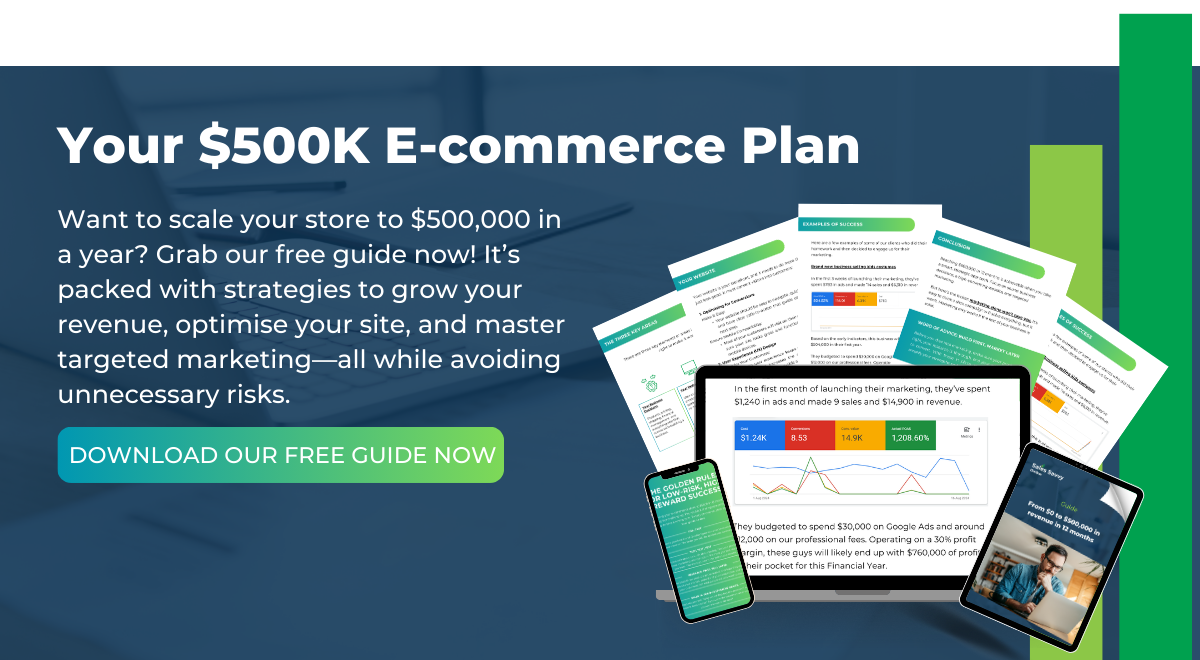Struggling to navigate the complex landscape of e-commerce marketing? You’re not the only one. Inspired by Carol Dweck’s growth mindset, this guide offers expert education on setting goals, conducting market research, and launching successful advertising campaigns. Learn how to shift your perception and build a digital marketing plan that drives real growth for your e-commerce business. Get ready to take your venture to the next level.
Identify Your Goals for E-Commerce Digital Marketing Strategies
Setting measurable objectives is crucial for e-commerce growth. By focusing on customer acquisition and retention strategies, businesses can enhance their credibility in a competitive market environment. Understanding target audience demographics and preferences helps tailor the marketing strategy effectively. Establishing key performance indicators ensures progress is tracked, while aligning marketing goals with the overall business vision fosters strong leadership. Regularly reviewing and adapting goals based on market trends keeps the strategy relevant.
Set Measurable Objectives for Your Online Business Growth
Setting measurable objectives like tracking sales through TikTok and email campaigns allows entrepreneurs to use Salesforce for analysing their market and enhancing problem solving. This targeted approach ensures online business growth is driven by clear, actionable goals and reliable data.
Focus on Customer Acquisition and Retention Strategies
Focusing on customer acquisition and retention strategies involves understanding the target market and utilising the right software to manage every touchpoint. By optimising stock levels and personalising interactions, e-commerce businesses can attract new customers and keep them loyal, ensuring sustainable growth.
Determine Your Target Audience Demographics and Preferences
Determining target audience demographics and preferences is key to effective online advertising and preventing costly failures. By utilising analytics, e-commerce businesses can uncover valuable insights into their customers’ behaviours and needs, ensuring that marketing efforts are precisely targeted. This focus not only enhances website usability but also supports steady cash flow by directing resources towards strategies that truly resonate with the intended audience.
Establish Key Performance Indicators to Track Progress
Using artificial intelligence and project management software, businesses can effortlessly monitor their key performance indicators, ensuring every dividend and enhancement to user experience is tracked accurately. Investing in training and development enables teams to interpret these metrics effectively, driving smarter decisions that fuel e-commerce growth.
Align Your Marketing Goals With Overall Business Vision
When digital marketing goals click with your business vision, brand awareness shoots through the roof. Smart goal setting and solid project management make it easy to target Asutralia and beyond, keeping your strategies on point and your brand message clear. This harmony ensures every marketing move pushes your business forward.
Review and Adapt Goals Based on Market Trends
As the e-commerce landscape shifts, developing adaptable goals helps businesses stay on top of trends like new payment methods. By tuning into industry podcasts and keeping an eye on market changes, companies can refine their value proposition to meet evolving customer needs. This proactive approach ensures their marketing strategy remains relevant and effective.
Conduct Thorough Market Research for E-Commerce Success
Conducting thorough market research is essential for e-commerce success and overall business health. By analysing competitors to identify strengths and weaknesses, gathering data on consumer behaviour and preferences, and studying industry trends, businesses can stay ahead of the curve. Using surveys and feedback enhances customer engagement and customer service, while evaluating pricing strategies and marketing channels drives innovation and supports academic achievement in marketing.
Analyse Competitors to Identify Strengths and Weaknesses
Analysing competitors allows e-commerce businesses to understand how their rivals leverage email marketing campaigns and manage employee benefits, particularly in regions like Finland. Breaking stereotypes in competitor strategies helps identify areas where cash investments can yield the most significant returns, enabling companies to refine their own approaches effectively.
Gather Data on Consumer Behaviour and Preferences
Understanding consumer behaviour and preferences is essential for crafting effective advertising messages. By collecting customers’ email addresses through engaging programs, businesses can analyse purchasing patterns and tailor their marketing efforts accordingly. This data-driven approach helps e-commerce owners build stronger relationships with their audience, ensuring their bank accounts stay happy.
Study Industry Trends to Stay Ahead of the Curve
By staying informed about the latest industry trends, e-commerce businesses can boost their customer lifetime value and optimise their small business marketing budget. This proactive approach in strategic management allows companies to adapt to the average market shifts, ensuring they remain competitive and continue to grow effectively.
Use Surveys and Feedback to Understand Customer Needs
Using surveys and feedback lets e-commerce businesses uncover what customers truly desire, easing financial risk with smart capital investments. By listening to the language customers use and leveraging the collected intelligence, companies can tailor their strategies to meet real needs. This ensures marketing efforts hit the mark and drive meaningful growth.
Evaluate Pricing Strategies and Market Positioning
Evaluating pricing strategies and market positioning involves understanding key concepts within the marketing mix to effectively place products in the marketplace. By treating pricing as a valuable asset, businesses can apply economic theories to set competitive yet profitable prices. This strategic approach ensures that e-commerce ventures stand out, attracting the right customers and maximising their market presence.
Map Out Potential Marketing Channels for Outreach
Choosing the right marketing channels is like investing wisely in the stock market or property; it’s all about efficiency and understanding your audience’s preferences. By leveraging accounting software to track campaign performance, businesses can make data-driven decisions that align with their implicit theories of intelligence, ensuring each outreach effort contributes to sustained e-commerce growth.
Develop a Comprehensive Content Marketing Strategy
Creating a comprehensive content marketing strategy involves crafting engaging content tailored to your audience through personalisation and thorough market analysis. Planning a content calendar ensures consistent posting, while incorporating SEO best practices boosts visibility. Utilising various content formats like blogs and videos, promoting through social media and newsletters, and monitoring performance allows businesses to adapt effectively, addressing conflict resolution and leveraging insights into neuroplasticity.
Create Engaging Content Tailored to Your Audience
Creating engaging content means blending creativity with a solid knowledge of your audience’s preferences. By tapping into social media effectively, e-commerce businesses can boost customer retention and build a dedicated workforce that champions their brand. This strategy ensures that every post and update truly connects, keeping customers interested and coming back for more.
Plan a Content Calendar for Consistent Posting
Planning a content calendar keeps your revenue flowing by making sure you’re always posting something fresh. Mix in text messaging campaigns with your social posts to keep customers engaged and coming back for more. Plus, using tools like Gusto can help you manage your marketing budget smartly, so you can focus on growing your business without stressing about credit or needing to chase small business loans.
Incorporate SEO Best Practices Into Your Writing
When you incorporate SEO best practices into your writing, you’re not just filling your website with words—you’re crafting an outline that speaks directly to your target audience. Using a straightforward methodology, you can seamlessly weave in keywords, giving your site the boost it needs for the reason that search engines have a soft spot for well-structured content. This way, your e-commerce store shines brighter online and draws in the right crowd.
Utilise Various Content Formats Like Blogs and Videos
Blending blogs, videos, and catchy newsletters helps e-commerce brands build a tight-knit community and streamline employee training. Plus, by addressing stereotype threats head-on, they highlight diverse employment stories, making the brand feel more genuine and approachable.
Promote Content Through Social Media and Newsletters
Promoting content via social media and newsletters means your team should harness generative artificial intelligence to create engaging posts without stretching your price. By fine-tuning marketing communications, e-commerce businesses can connect with their audience more effectively, driving growth and keeping customers coming back for more.
Monitor Content Performance and Adjust as Necessary
Using HubSpot to monitor content performance enables e-commerce businesses to forecast trends and refine their marketing channels effectively. By analysing the emotion behind customer interactions during onboarding, companies can make informed adjustments that better resonate with their audience. This proactive approach ensures that marketing efforts stay relevant and continuously drive growth.
Optimise Your E-Commerce Website for User Experience
Optimising an e-commerce website is all about grabbing attention and fine-tuning user experience. From mobile responsiveness and smooth navigation to faster load times, clear calls-to-action, detailed product descriptions, and genuine customer reviews, each element relies on sound strategy and research. A SWOT analysis and understanding the science of user behavior ensure these optimizations hit the mark.
Ensure Mobile Responsiveness for All Devices
Ensuring mobile responsiveness is key to accommodating diverse customer behaviours across devices. Data reveals that many shoppers browse and buy on their phones, so businesses should document any mobile issues and adapt their sites accordingly. By diversifying the design to fit various screens, e-commerce stores can provide a smoother user experience, backed by evidence that responsive sites lead to higher engagement and sales.
Streamline Navigation to Enhance User Journey
Streamlining navigation is key to boosting sales and enhancing the customer experience on an e-commerce website. By organising content strategically and ensuring intuitive pathways, businesses can guide visitors smoothly through their site, making it easier to find products and information. Integrating platforms like Pinterest can further enrich the user journey, providing visually engaging touchpoints that align with the overall content strategy.
Speed Up Page Loading Times for Better Engagement
Faster page loading times can significantly lower customer acquisition cost by keeping potential buyers engaged and confident in the site’s reliability. When users experience quick, smooth navigation, they’re more likely to praise the seamless experience and help the business reach its growth goal. Efficient content distribution further enhances the user journey, ensuring visitors stay longer and convert more effectively.
Implement Clear Calls-to-Action for Conversions
Implementing clear calls-to-action (CTAs) can guide customers’ brains towards making quick purchase decisions, leveraging growth hacking techniques to boost conversions. Streamlined workflows ensure CTAs are strategically placed, enhancing customer loyalty by making the buying process seamless. Continuous learning from user interactions allows businesses to refine their CTAs, driving sustained e-commerce growth.
Enhance Product Pages With Rich Descriptions
Enhancing product pages with rich descriptions involves leveraging market research to understand customer psychographics and using influencer marketing to create authentic content. Building a strong bond with shoppers through detailed, engaging narratives and including direct telephone contact information can significantly boost trust and conversion rates. This approach ensures that every product page resonates with the target audience, driving sustained e-commerce growth.
Use Customer Reviews to Build Trust and Credibility
Displaying customer reviews on an e-commerce site transforms the workplace into a more transparent environment, helping businesses grasp their customers’ personas better. This insight directly contributes to a higher return on investment and increased profit by informing smarter pricing strategies. Genuine feedback not only builds trust and credibility but also guides improvements that resonate with shoppers, ensuring the website meets their needs effectively.
Execute Targeted Social Media Campaigns for Engagement
Executing targeted social media campaigns boosts engagement by choosing the right platforms for your audience and developing a unique brand voice that resonates. Regular updates and interactive content keep motivation high, while using analytics for iteration refines your strategy. Collaborating with influencers broadens reach, and engaging with followers through comments and messages strengthens your value proposition amidst competition.
Choose the Right Platforms for Your Audience
Choosing the right social media platforms for your audience requires critical thinking and a deep understanding of their online habits. By investing time into analysing where your customers spend their time, businesses can enhance the overall experience and ensure their supply chain messaging aligns with platform-specific climates. This strategic approach not only boosts engagement but also maximises your marketing investment.
Develop a Unique Brand Voice That Resonates
Crafting a unique brand voice starts with a solid belief in your entrepreneurship journey, drawing inspiration from Stanford University’s progressive pedagogy on effective communication. By leveraging customer relationship management tools, e-commerce businesses can tailor their messaging to resonate deeply with their audience, ensuring every interaction feels personal and authentic. This approach not only differentiates the brand but also builds lasting connections with customers, fostering loyalty and trust.
Schedule Regular Updates and Interactive Content
Regularly scheduling updates and interactive content keeps the brand lively and ensures resources are used wisely through smart content creation. This consistent engagement helps customers feel connected and more comfortable using their credit cards, driving e-commerce growth effectively. By keeping the conversation going, businesses build stronger relationships that turn casual browsers into loyal buyers.
Use Analytics to Refine Your Social Media Strategy
By leveraging Google Analytics, e-commerce businesses can fine-tune their social media strategies without blowing their budget, even during a recession. This technology empowers teams with insights that drive smarter decisions, enhancing employee engagement and ensuring every marketing expense counts.
Collaborate With Influencers to Broaden Reach
Collaborating with influencers can significantly boost your search engine presence and lead generation by leveraging their loyal followers. Using marketing automation tools, e-commerce businesses can efficiently manage these partnerships, ensuring sustained interest and engagement. Even industries like mortgage services find value in influencer collaborations, as authentic endorsements can build trust and drive customer acquisition effectively.
Engage With Followers Through Comments and Messages
Engaging with followers through comments and messages, both online and offline, can cut customer service costs and create a friendly learning environment. Prompt, personal responses give businesses a competitive advantage and build trust, ultimately boosting their finance health.
Measure and Analyse Performance to Refine Your Strategy
To refine their marketing strategies, companies use analytics tools to track website traffic and sales, review campaign performance against objectives, and identify areas for improvement based on data. With dashboards and the mathematics of trends, they adjust strategies for seasonal shifts. Conducting A/B testing and documenting findings adds value to future human resources and marketing initiatives.
Use Analytics Tools to Track Website Traffic and Sales
Utilising analytics tools, e-commerce businesses can gain invaluable insights into website traffic and sales, allowing them to refine their strategies through peer review and data-driven decisions. By understanding consumer behaviours and retail trends, companies can allocate their energy more effectively, ensuring that every marketing dollar, whether from a loan or revenue, is optimised for maximum impact.
Review Campaign Performance Against Set Objectives
Reviewing campaign performance against set objectives is essential for fine-tuning your e-commerce strategy. By leveraging automation tools like Mailchimp, businesses can efficiently track key metrics and gather valuable feedback from customers. This robust infrastructure allows entrepreneurs to make informed decisions, ensuring their marketing efforts align perfectly with their goals.
Identify Areas for Improvement Based on Data
By analysing sales data and customer interactions, e-commerce businesses can spot where money is slipping away and make informed adjustments to their marketing curriculum. This targeted approach ensures that every section of their strategy, much like a well-organised table of contents, directly contributes to increasing net income. Leveraging these insights helps streamline efforts, ultimately driving sustained growth and financial stability.
Adjust Your Strategy Based on Seasonal Trends
By leveraging market segmentation and analysing seasonal trends, e-commerce businesses can collaborate effectively with partners to boost income during peak periods, reducing debt-related stress. Creating infographics to visualize sales data helps identify patterns, allowing entrepreneurs to adjust their strategies proactively and maintain steady growth throughout the year.
Conduct a/B Testing for Marketing Materials
A/B testing allows e-commerce businesses to fine-tune their social media marketing and product presentations by comparing different versions of marketing materials. This strategic planning tool enhances management by providing clear data on what resonates with customers, fostering a culture of continuous improvement and informed decision-making.
Document Findings for Future Marketing Initiatives
By systematically documenting marketing performance, e-commerce businesses can identify which strategies garnered earned media and boosted productivity. This record helps entrepreneurs make informed decisions about future campaigns, whether they’re considering applying for a business loan or seeking mentorship to enhance their design and outreach efforts. Ultimately, keeping detailed findings ensures that every initiative builds on past successes, driving sustained growth.
Conclusion
Building a winning digital marketing plan is your ticket to e-commerce success, setting clear goals that drive growth. By truly understanding your audience and optimising your website, you create a seamless shopping experience that keeps customers coming back. Engaging content and targeted social media campaigns ensure your brand stays top of mind and ahead of the competition. Regularly analysing your performance helps you stay agile, making smart adjustments that sustain your business’s momentum.



